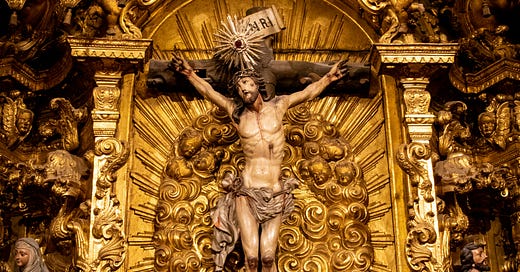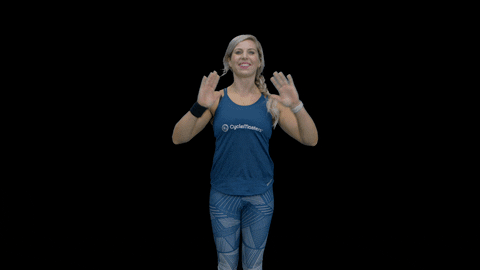"God" today is what consumes most of our energy—money, sex, work, our phones, or increasingly, the optimized self. The meaning of "worship" now exists far beyond religious contexts.
This past year I did a spending audit, i.e. saw where I spent most of my money, and 80% of my paycheck flowed directly into the wellness industrial complex:
A destination Equinox membership
Bi-weekly sauna/cold plunge experiences (shout-out Othership)
Daily Whole Foods hauls
Supplement and arbitrary health subscriptions like cymbiotika, coconut cult, protein powders, collagens, adaptogens, etc.
Expensive yoga classes
Acupuncture sessions
Gadgets like red light therapy masks, gua shas, etc.
Diagnostic subscriptions like
and SuperpowerYearly wellness retreats
...the list goes on
My goal through the audit was finding a career passion, which manically pointed to wellness.
I'm not devoted to a single practice, I subscribe to a rather polytheistic mental model of wellness than monotheistic. Less faithful disciple, more ‘venture capitalist’ hedging positions across the wellness spectrum to maximize returns on wellbeing.
Wellness culture has methodically replicated the structures, language, and psychological mechanisms of religious systems, creating a secular faith with its own dogmas, priests, and penitential systems.
The $6 trillion global wellness industry hasn't just tapped into our health anxieties—it's colonized the psychological territory previously occupied by religion.
Digital Confession Culture
The Before-and-After as Redemption Narrative
Religious conversion testimonies follow a consistent structure: life in sin, moment of realization, transformation through faith, and new life of virtue.
Wellness testimonies replicate this formula remarkably, the transformation narratives follow the same four-part structure as religious conversions:
The sinful past: People reject their former selves—condemned for eating processed food, living sedentary lives, and harboring negative thoughts.
The awakening: A jarring turning point demanding attention—health crises, emotional breakdowns, or vanity suddenly tunes their antenna on to the "wellness message."
The intervention: They discover salvation through a charismatic influencer or community who guides their conversion.
The salvation: They transform through visible results—better appearance, energy levels, or mental clarity—then evangelize to convert others.
Take tech entrepreneur Bryan Johnson: unhealthy lifestyle (sin), moment of clarity about mortality after selling his company for $800 million (awakening), development of his Blueprint protocol (intervention), and transformation into a biohacking evangelist helping followers reverse their biological age (salvation). His narrative functions identically to a religious testimony, just with more viral erections.
These transformation posts serve the same psychological and social function as public testimonies in evangelical traditions—they validate the belief system, create social cohesion, and reinforce the convert's commitment by making it public.
Social Media as Confessional Space
Religious traditions built physical confessional spaces, and wellness culture developed digital equivalents serving the same function.
Several wellness social media practices mirror secularized confession:
"What I Eat in a Day" videos: These structured food diaries function as public accounting of consumption. Most creators serve as performance of virtue rather than documentation of reality.
Fitness tracking apps: Platforms like Strava, Fitbit, and Apple Health automatically generate confessional content. Users describe missing step goals in explicitly moral terms—"I was bad yesterday" or "I failed today"—language previously reserved for religious transgression.
Wellness challenge check-ins: Social media groups dedicated to specific protocols (75 Hard, Whole30) require regular public accountability. The anxiety around missing a check-in exceeds the anxiety of missing the actual practice.
The metrics-driven nature of these confessions—step counts, calorie intake, meditation minutes—quantifies moral assessment.
We've traded in rosary beads for Oura rings, but we're still counting our way to redemption.
Influencer as Priest
Religious leaders establish authority through personal transformation narratives. Wellness influencers do the same for credibility.
Examples:
Bryan Johnson built Blueprint on his transformation from burned out tech CEO to anti-aging zealot. His $2 million yearly protocol and obsessive biomarker tracking substitutes eternal salvation with biological age reduction—immortality through metrics instead of faith.
Dr. Zach Bush transformed from triple board-certified physician to microbiome evangelist after a crisis of faith in conventional medicine. His conversion arc was him pivoting from prescribing pills to crusading for holistic health.
David Asprey built Bulletproof around his transformation from "fat, sluggish executive" to "optimized biohacker." His authority stems from personal redemption, not scientific credentials per se.
Wim Hof built his breathing and cold exposure method after overcoming grief following his wife's suicide. He positions his method as divinely inspired during his darkest moment.
Wellness influencers employ classic religious credentialing—the personal transformation story establishes their connection to higher wisdom, while their apparent results provide proof of their methods' efficacy.
This pattern extends to brand founders too. John Mackey framed Whole Foods as the result of his personal awakening to the healing power of food following illness. Chip Wilson positioned Lululemon as emerging from his personal transformation through yoga. In both cases, the origin story established authority through personal redemption.
They’ve inspired millions, myself included. Humans have always gravitated towards charismatic voices—our evolutionary wiring naturally responsive to authentic conviction; sometimes for the absolute worst — as seen in:
Modern Wellness as Religious Ritual
Morning Rituals
Morning routines today mirror purification rites across cultures. We've replaced deities with the optimized of self.
Elaborate 12-step morning routines match monastic morning offices exactly. Both begin with purification, progress through devotional practices, and conclude with preparation for the day's work—only the deity being worshipped has changed from God to the optimized self.
This commercialization has created a $10.3 billion "morning wellness" market.
Neuroscientists have confirmed that when participants perform ritualized wellness behaviors, they see activation in the same brain regions that light up during religious ritual. The anterior cingulate cortex and ventromedial prefrontal cortex show identical activation patterns during prayer, meditation, and wellness routines.
In "The Creative Act," music producer Rick Rubin explores this concept from an artistic perspective. Rubin argues that ritualistic practices create a gateway to transcendence, not through the actions themselves but through how they transform our perception. He writes that daily rituals help us "connect to source"—his term for the universal creative energy that powers artistic expression.
"The purpose isn't in the doing," Rubin explains, "but to evolve how we see the world when we are not engaged in these acts." These rituals build what he calls the "musculature of our psyche," training our minds to perceive reality with greater clarity and creative potential.
Rubin's artistic framework aligns well with Dr. Taylor's neuroscience. Both identify the transformative power of ritual lying not in the specific actions performed but in how those actions reshape our consciousness. The neural pathways activated through consistent ritual practice create lasting changes in perception that extend beyond the ritual itself.
This explains why wellness practices with little scientific evidence provide real psychological benefits when performed ritualistically. The ritual structure serves a fundamental human need previously met by religious observance.
Fasting as Secular Sacrament
The semantic appropriation between religious fasting vs. wellness fasting (i.e., "purging the body of sin" vs. "flush toxins from the body") extends to technical terms like "autophagy" (self-consumption)—a cellular cleaning process promoted during fasting—which functions in wellness discourse as the modern equivalent of spiritual self-discipline.
Nobel Prize winner Yoshinori Ohsumi's research on autophagy is reframed in wellness culture as cellular redemption through suffering, paralleling religious austerity.
Wellness Retreats as Secular Pilgrimages
Modern wellness retreats today closely mirror religious retreats.
Religious studies professor Dr. James Coleman's three-year ethnographic study identified several key structural parallels:
Separation from ordinary life: Religious pilgrimages require physical removal from daily existence. Modern wellness destinations like Esalen Institute modeled aspects of traditional ashrams to cultivate this sense of separation.
Ascetic practices: Religious retreats involve intentional deprivation as spiritual discipline. Modern wellness retreats reframe this as detoxification. The Ranch Malibu makes people surrender phones, eat 1,400 daily calories of vegan food, and hike 12 miles daily. Founder Alex Glasscock describes it as "breaking down the body to build it back stronger"—language similar to monastic discipline.
Group confession: Religious retreats include confessionals. Wellness retreats include "sharing circles" where participants reveal their struggles. These follow identical psychological patterns to religious confession—public acknowledgment of transgression, group validation, and collective reinforcement of shared values.
The transformational language of wellness retreats—promises of "rebirth," "awakening," and "journeys of transformation"—reveals our enduring search for transcendence, repackaged for secular consumption.
Fitness Studios as Modern Cults
I was at SoulCycle the other day and couldn't help but notice the religious undertones—darkened rooms and precisely calibrated 158bpm music driving heart rates to transcendental states while spotlight-illuminated instructors commanded movements like modern-day priests leading worship.
Boutique fitness studios actively use religious architectural and ritual elements to create spaces of secular worship. These studios employ "spatial sacralization - design elements from religious spaces that evoke transcendent experiences.
The darkened room, elevated instructor platform, synchronized movements, and carefully selected music create what religious scholars call a 'liminal space - a threshold between ordinary reality and transcendent experience. Religious institutions have employed these elements for millennia to facilitate collective ecstatic experiences.
A major sociological pattern matching religious sect membership is charismatic leadership, often teetering on dark and cynical manipulation. Bikram Choudhury, founder of Bikram Yoga, manipulated followers into worshiping him as a guru, comparing himself to Jesus Christ or Buddha. He directly exploited devotees for financial and sexual gain.
CrossFit, with its "boxes" instead of gyms, WODs (Workouts of the Day) rather than routines, and passionate defense of methodology against critics, exhibits strong cult-like characteristics. Members show higher levels of identity fusion with their fitness community than with most other social groups—a pattern observed in religious communities. They don't just drink the Kool-Aid; they mix it with protein powder too.
The economic model strengthens the cult-like nature. Equinox's tiered membership system—with increasingly exclusive access at higher price points—mirrors historical religious practices where greater financial contribution granted access to inner sanctums. The $500+ monthly membership for destination clubs transforms conspicuous consumption into conspicuous virtue—a modern form of indulgence.
This cult-like devotion explains why members continue paying premium prices despite studies showing no significant difference in fitness outcomes between boutique studios and traditional exercise. The Journal of Exercise Physiology's 2023 meta-analysis confirmed that boutique fitness programs offer no significant advantage over standard exercise protocols—yet members remain fiercely loyal.
What these studios sell isn't physical transformation but spiritual experience in secular packaging—a modern form of religious belonging designed to appear non-religious while satisfying the same psychological needs previously met by traditional faith communities.
~ final thoughts
The rise of wellness ritualization correlates directly with declining religious participation in Western countries.
As traditional religious affiliation has declined, wellness practices have incorporated religious structures to meet unchanged human needs for community, meaning, and moral frameworks.
Society bears responsibility here. As Nietzsche predicted with his "God is dead" proclamation, we've abandoned traditional moral frameworks without replacing the psychological infrastructure they provided. The resulting internal fragmentation leaves us vulnerable to new systems of meaning—however expensive or pseudoscientific.
Hence the move toward the optimized self, our yearning for omnipotence through the human experience (shout out Bryan Johnson).
The wellness industry filled this void perfectly. It offers salvation through optimization, community through exclusive membership, and moral frameworks through rigid protocols. But unlike traditional religion, it lacks accountability structures or social responsibility requirements.
The $6 trillion we collectively spend on wellness annually isn't just consumer behavior—it's the largest unacknowledged religious movement in human history. We've replaced the promise of eternal life with the promise of extended healthspan, traded sin for inflammation, and substituted priests with influencers.











Very well put — especially cool to see the parallels between pilgrimages and wellness retreats. One thing I kept wondering while reading:
Do you see the secularization of wellness as ultimately empowering, or are there risks in how it replaces traditional moral frameworks without offering the same forms of accountability or community responsibility? What direction is this leading us to?
You hinted to something important being missing / left behind in humanity's rush towards modern day wellness, but did not elaborate on the ramifications of this change:
"we're still counting our way to redemption."
"we've abandoned traditional moral frameworks without replacing the psychological infrastructure they provided. The resulting internal fragmentation leaves us vulnerable to new systems of meaning... Hence the move toward the optimized self, our yearning for omnipotence through the human experience... But unlike traditional religion, it lacks accountability structures or social responsibility requirements."
What happens if we keep going down this road, with no concern for properly establishing accountability structures and a framework for a moral compass?
Maybe it's worth exploring in a separate post, but would love to hear your take.
This is such a brilliant analogy.! The way wellness has evolved into a new kind of religion with its own sacred texts: self-help books, rituals: morning routines, ice baths, supplement stacks, and high priests: biohackers, longevity experts, influencers, feels so accurate. There’s a moral undertone to it too, where discipline and optimization are seen as signs of worthiness, and any deviation is almost treated like a personal failing.
I recently wrote about how wellness feels like the new hustle culture, but I really love your framing of it as a religion. In both cases, the underlying message is often the same: you are not enough as you are, and there is always more to optimize, more to improve, more to strive for. It’s exhausting, and yet, like any belief system, it offers a sense of structure and control in an uncertain world.